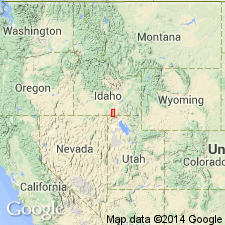
- Usage in publication:
-
- Land Creek Formation
- Modifications:
-
- Named
- Dominant lithology:
-
- Schist
- Limestone
- AAPG geologic province:
-
- Great Basin province
Summary:
Named as one of eight formations of Dove Creek Group (new) for exposures in the Albion Range between saddle 1.8 mi north of Mount Harrison in E1/2 sec 32, T12S, R24E and basin of Land Creek on west side of range in E1/2 sec 1, T13S, R23E, secs 6 and 7, T13S, R24E, Cassia Co, ID in the Great Basin province. No type locality designated. Geologic map; mapped at northwest part of Albion Range area. Overlies Ordovician and Cambrian Harrison Summit Quartzite (new) of Dove Creek Group; lower contact placed at base of schist or carbonate with massive quartzite of Harrison Summit. Underlies Ordovician Dayley Creek Quartzite (new) of Dove Creek Group; upper contact placed at base of quartzite. Is about 1,500 ft thick. Consists of blue-gray limestone and an overlying graphitic staurolite-garnet-muscovite-quartz schist near Land Creek. Three mi away north of Mount Harrison, the only carbonate is porphyroblasts of calcite in biotite-muscovite-quartz schist near base; the overlying part is garnet and staurolite-bearing, biotite-muscovite-quartz schist (without graphite) and micaceous conglomeratic quartzite interbeds. Ordovician to Cambrian age.
Source: GNU records (USGS DDS-6; Denver GNULEX).
For more information, please contact Nancy Stamm, Geologic Names Committee Secretary.
Asterisk (*) indicates published by U.S. Geological Survey authors.
"No current usage" (†) implies that a name has been abandoned or has fallen into disuse. Former usage and, if known, replacement name given in parentheses ( ).
Slash (/) indicates name conflicts with nomenclatural guidelines (CSN, 1933; ACSN, 1961, 1970; NACSN, 1983, 2005, 2021). May be explained within brackets ([ ]).

